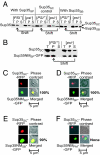Prion species barrier between the closely related yeast proteins is detected despite coaggregation
- PMID: 17296932
- PMCID: PMC1815260
- DOI: 10.1073/pnas.0611158104
Prion species barrier between the closely related yeast proteins is detected despite coaggregation
Abstract
Prions are self-perpetuating and, in most cases, aggregation-prone protein isoforms that transmit neurodegenerative diseases in mammals and control heritable traits in yeast. Prion conversion requires a very high level of identity of the interacting protein sequences. Decreased transmission of the prion state between divergent proteins is termed "species barrier" and was thought to occur because of the inability of divergent prion proteins to coaggregate. Species barrier can be overcome in cross-species infections, e.g., from "mad cows" to humans. We studied the counterparts of yeast prion protein Sup35, originated from three different species of the Saccharomyces sensu stricto group and exhibiting the range of prion domain divergence that overlaps with the range of divergence observed among distant mammalian species. All three proteins were capable of forming a prion in Saccharomyces cerevisiae, although prions formed by heterologous proteins were usually less stable than the endogenous S. cerevisiae prion. Heterologous Sup35 proteins coaggregated in the S. cerevisiae cells. However, in vivo cross-species prion conversion was decreased and in vitro polymerization was cross-inhibited in at least some heterologous combinations, thus demonstrating the existence of prion species barrier. Moreover, the barrier between the S. cerevisiae protein and its Saccharomyces paradoxus and Saccharomyces bayanus counterparts was asymmetric both in vivo and in vitro. Our data show that a decreased cross-species prion transmission does not necessarily correlate with a lack of cross-species coaggregation, suggesting that species-specificity of prion transmission is controlled at the level of conformational transition rather than coaggregation.
Conflict of interest statement
The authors declare no conflict of interest.
Figures




Similar articles
-
Conformational diversity in a yeast prion dictates its seeding specificity.Nature. 2001 Mar 8;410(6825):223-7. doi: 10.1038/35065632. Nature. 2001. PMID: 11242084
-
Mechanism of cross-species prion transmission: an infectious conformation compatible with two highly divergent yeast prion proteins.Cell. 2005 Apr 8;121(1):49-62. doi: 10.1016/j.cell.2005.03.008. Cell. 2005. PMID: 15820678
-
The [URE3] prion is not conserved among Saccharomyces species.Genetics. 2005 Sep;171(1):23-34. doi: 10.1534/genetics.105.043489. Epub 2005 Jun 14. Genetics. 2005. PMID: 15956663 Free PMC article.
-
Insights into the mechanism of prion propagation.Curr Opin Struct Biol. 2008 Feb;18(1):52-9. doi: 10.1016/j.sbi.2007.12.005. Curr Opin Struct Biol. 2008. PMID: 18243685 Review.
-
[New aspects of research upon the yeast Saccharomyces cerevisiae [PSI+] prion].Postepy Biochem. 2007;53(2):182-7. Postepy Biochem. 2007. PMID: 17969880 Review. Polish.
Cited by
-
Site-specific structural analysis of a yeast prion strain with species-specific seeding activity.Prion. 2011 Jul-Sep;5(3):208-14. doi: 10.4161/pri.5.3.16694. Epub 2011 Jul 1. Prion. 2011. PMID: 22048721 Free PMC article.
-
Contributions of the Prion Protein Sequence, Strain, and Environment to the Species Barrier.J Biol Chem. 2016 Jan 15;291(3):1277-88. doi: 10.1074/jbc.M115.684100. Epub 2015 Nov 12. J Biol Chem. 2016. PMID: 26565023 Free PMC article.
-
W8, a new Sup35 prion strain, transmits distinctive information with a conserved assembly scheme.Prion. 2015;9(3):207-27. doi: 10.1080/19336896.2015.1039217. Prion. 2015. PMID: 26038983 Free PMC article.
-
Dynamic interactions of Sup35p and PrP prion protein domains modulate aggregate nucleation and seeding.Prion. 2008 Jul-Sep;2(3):99-106. doi: 10.4161/pri.2.3.7147. Prion. 2008. PMID: 19195120 Free PMC article.
-
Heterologous cross-seeding mimics cross-species prion conversion in a yeast model.BMC Biol. 2009 May 26;7:26. doi: 10.1186/1741-7007-7-26. BMC Biol. 2009. PMID: 19470166 Free PMC article.
References
Publication types
MeSH terms
Substances
LinkOut - more resources
Full Text Sources
Molecular Biology Databases

